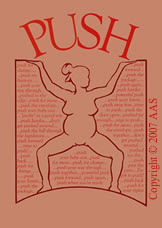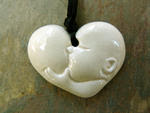and banning people who attempt to have a real dialogue and debate about maternal childbirth care.
In November, I was banned five times from certain non-practicing OB's blog and now she is continuing to ban anyone who challenges her -- anyone with evidence to confront her is ridiculed and banned. She has left a wake of injured women -- those who attempt to share their own positive birth experiences with a midwife and at home are ridiculed and told, "It's simply not true; there is no scientific evidence to prove it." It is time for women and doctors to come together to create healthy, safe birth for women and babies. The science is clear that there needs to be a system that gives the responsiblity for birth to women and that supports-- no, insists on healthy, low risk women to either birth without drugs, interventions, or disruptions in the hospital environment or to birth at home with access to medical care.
Midwife, Maribeth has recently been banned and here is what she wanted to post in response to an attack on her previous post, a quality study that shows that midwifery care is safer for women and babies.
From the research that she posted: The cesarean section rate was 13% among women in the midwife group versus 34% in the physician group, a difference that also was not explained by health status alone. (The rates were 5.6% and 15.6% respectively after excluding women with preexisting chronic medical conditions.)
THERE IS NO SCIENTIFIC RESEARCH to show that CESAREAN birth is safe and there is plenty to show that it is emotionally, physiologically, financially, and spiritually detrimental to the mother and baby. It is known to have serious respiratory, heart, and ear issues for the baby, as well as serious separation and attachment issues, all of which persist throughout the lifetime. It's 'bout time the OB's started showing care for the health of women and babies and led the way in creating safer, evidence-based hospital care, and providing homebirth women with respectful, caring, and quality medical care WHEN they need it. It's about time legislators intervened in money and peer-driven medical machine called maternal care. Why is that pregnant women, the consumers, must fight for what is right, logical, ethical, and scientific?
Maribeth:
And you still haven't answered the only question which continues to interest me, and that is why, on a personal level, homebirth/natural childbirth is SUCH an issue to you, why it makes you feel so angry and defensive and why you want to see it deconstructed and defeated. The answer to this question is at the very root of this blog. I beg you Amy to answer the question, and better yet, honestly. Saying that you're trying to provide information isn't good enough, because of course you could be dedicating your life to educating women about the risks of, say, episiotomies. (Which might offer you some emotional absolution for past wrongs). But why this issue? Frankly, why do you care what women do with their own vaginas?
In response to a negative response to:
Pilot Study Suggests Midwifery Care is Optimal for Moderate-Risk Women
Cragin L, Kennedy HP. (2006)
Linking obstetric and midwifery practice with optimal outcomes.
Journal of Obstetric, Gynecologic and Neonatal Nursing, 35(6), 779-85. [Abstract]
Summary: This study compared the pregnancy, birth and postpartum care practices and outcomes experienced by 196 moderate-risk women receiving nurse midwifery care with those of 179 similar women receiving physician care in the same hospital-based faculty practice. Each woman was assigned an "Optimality Index - US" score, calculated from 40 variables measuring optimal health status, care practices and outcomes. A companion "Perinatal Background Index" (PBI) score that captured demographic and health history was also assigned. Together, the two scores provide a valid measure of the process and outcomes of care within the context of the clinical situation of the individual woman.Women in the midwife group had significantly higher optimality scores than women in the physician group (79% versus 70%). While some of this difference was attributable to differences in baseline medical risks (as measured by significant differences in PBI score), statistical analysis revealed that the provider type (i.e. midwife or physician) was twice as predictive of optimality scores. The cesarean section rate was 13% among women in the midwife group versus 34% in the physician group, a difference that also was not explained by health status alone. (The rates were 5.6% and 15.6% respectively after excluding women with preexisting chronic medical conditions.) In various statistical analyses, only type of provider accurately predicted cesarean rates in the two groups.Women in the midwife group were more likely to drink or eat (95% versus 80%), maintain mobility in labor (68% versus 28%), and use non-pharmacologic methods of pain relief (88% versus 51%). Epidural use was lower in the midwife group (31% versus 51%), as was use of any pharmacologic pain relief methods (64% versus 82%).
Significance for Normal Birth: Traditional measures of maternity care outcomes have focused on morbidity and mortality indicators. This approach has several drawbacks. In the United States morbidity and mortality are fortunately rare, so studies assessing these outcomes must be large in order to demonstrate significant differences. Furthermore, these "negative" indicators are poor measures of the effectiveness of care that is intended to promote "positive" outcomes like health and wellness in population experiencing a physiologically normal process.
The Optimality Index - US has emerged as an important new tool for measuring maternity care to capture both the process and outcomes of different styles of practice. In this and other studies, midwifery care has been associated with high optimality, demonstrating appropriate use of interventions and good outcomes given the individual women's clinical situations. Midwives are often assumed to care for only low-risk women but many midwives also care for women at moderate or high risk. This study finds that midwifery may be optimal for moderate risk population by promoting good outcomes with less reliance on technological and surgical intervention and a greater attention to the care practices that support normal birth.
Baby Keeper says:
NOW, let's look at what drugs, technology, and surgical interventions do to the baby!! It's the BABY's birth --- and the baby gets to live with the consequences for his or her life.
Baby Keeper: One who Keeps the Baby as the focus of the soul's journey of birthing into this world.
The Other Side of the Glass
Part One was officially released June 2013 in digital distribution format.
To purchase to to www.theothersideoftheglass.com
If you were a donor and want to download your copy send an email to theothersideoftheglassfilm@gmail.com.
The trailer
Thursday, March 22, 2007
Subscribe to:
Post Comments (Atom)
"Soft is the heart of a child. Do not harden it."
A public awareness reminder that things that happen behind the scenes, out of our sight, aren't always as rosy as we might think them to be. Perhaps its a restaurant cook who accidentally drops your burger
on the floor before placing it on the bun and serving it to you. Here it's an overworked apathetic (pathetic) nurse giving my newborn daughter her first bath.
Please comment and rate this video, so as to insure that it is viewed as widely as possible, perhaps to prevent other such abuse. -- The mother who posted this YouTube. How NOT to wash a baby on YouTube
Are you going to try to tell me that "babies don't remember?" There is no difference to this baby's experience and the imprinting of her nervous system/brain and one that is held and cleaned by the mother or father either at the hospital or at home?
By the way, this is probably NOT the baby's first bath. The nurse is ungloved. Medical staff protocol is that they can't handle a baby ungloved until is has been bathed (scrubbed if you've seen it) because the baby is a BIO-HAZARD -- for them. Never mind that the bio-hazard IS the baby's first line of defense against hospital germs.
Missouri Senator Louden Speaks
Finally, A Birth Film for Fathers
Part One of the "The Other Side of the Glass: Finally, A Birth Film for and about Men" was released June, 2013.
Through presentation of the current research and stories of fathers, the routine use of interventions are questioned. How we protect and support the physiological need of the human newborn attachment sequence is the foundation for creating safe birth wherever birth happens.
Based on knowing that babies are sentient beings and the experience of birth is remembered in the body, mind, and soul, fathers are asked to research for themselves what is best for their partner and baby and to prepare to protect their baby.
The film is designed for midwives, doulas, and couples, particularly fathers to work with their caregivers. Doctors and nurses in the medical environment are asked to "be kind" to the laboring, birthing baby, and newborn. They are called to be accountable for doing what science has been so clear about for decades. The mother-baby relationship is core for life. Doctors and nurses and hospital caregivers and administrators are asked to create protocols that protect the mother-baby relationship.
Men are asked to join together to address the vagaries of the medical system that harm their partner, baby and self in the process of the most defining moments of their lives. Men are asked to begin to challenge the system BEFORE they even conceive babies as there is no way to be assured of being able to protect his loved ones once they are in the medical machine, the war zone, on the conveyor belt -- some of the ways that men describe their journey into fatherhood in the medicine culture.
Donors can email theothersideoftheglassfilm@gmail.com to get a digital copy.
Through presentation of the current research and stories of fathers, the routine use of interventions are questioned. How we protect and support the physiological need of the human newborn attachment sequence is the foundation for creating safe birth wherever birth happens.
Based on knowing that babies are sentient beings and the experience of birth is remembered in the body, mind, and soul, fathers are asked to research for themselves what is best for their partner and baby and to prepare to protect their baby.
The film is designed for midwives, doulas, and couples, particularly fathers to work with their caregivers. Doctors and nurses in the medical environment are asked to "be kind" to the laboring, birthing baby, and newborn. They are called to be accountable for doing what science has been so clear about for decades. The mother-baby relationship is core for life. Doctors and nurses and hospital caregivers and administrators are asked to create protocols that protect the mother-baby relationship.
Men are asked to join together to address the vagaries of the medical system that harm their partner, baby and self in the process of the most defining moments of their lives. Men are asked to begin to challenge the system BEFORE they even conceive babies as there is no way to be assured of being able to protect his loved ones once they are in the medical machine, the war zone, on the conveyor belt -- some of the ways that men describe their journey into fatherhood in the medicine culture.
Donors can email theothersideoftheglassfilm@gmail.com to get a digital copy.
Buy the film at www.theothersideoftheglass.com.
The film focuses on the male baby, his journey from the womb to the world and reveals healing and integrating the mother, father, and baby's wounded birth experience. The film is about the restoring of our families, society, and world through birthing loved, protected, and nurtured males (and females, of course). It's about empowering males to support the females to birth humanity safely, lovingly, and consciously.
Finally, a birth film for fathers.
The film focuses on the male baby, his journey from the womb to the world and reveals healing and integrating the mother, father, and baby's wounded birth experience. The film is about the restoring of our families, society, and world through birthing loved, protected, and nurtured males (and females, of course). It's about empowering males to support the females to birth humanity safely, lovingly, and consciously.
Finally, a birth film for fathers.
What People Are Saying About the FIlm
Well, I finally had a chance to check out the trailer and .. wow! It's nice that they're acknowledging the father has more than just cursory rights (of course mom's rights are rarely acknowledged either) and it's great that they're bringing out the impact of the experience on the newborn, but I'm really impressed that they're not shying away from the political side.
They are rightly calling what happens in every American maternity unit, every day, by its rightful name - abuse. Abuse of the newborn, abuse of the parents and their rights, abuse of the supposedly sacrosanct ethical principal of patient autonomy and the medico-legal doctrine of informed consent, which has been long ago discarded in all but name. I love it!
In the immortal words of the "shrub", "bring it on!" This film needs to be shown and if I can help facilitate or promote it, let me know.
Father in Asheville, NC
Thanks for sharing this. It was very touching to me. I thought of my brother-in-law standing on the other side of the glass when my sister had to have a C-section with her first child because the doctor was missing his golf date. I'll never forget his pacing back and forth and my realizing that he was already a father, even though he hadn't been allowed to be with his son yet.
Margaret, Columbia, MO
They are rightly calling what happens in every American maternity unit, every day, by its rightful name - abuse. Abuse of the newborn, abuse of the parents and their rights, abuse of the supposedly sacrosanct ethical principal of patient autonomy and the medico-legal doctrine of informed consent, which has been long ago discarded in all but name. I love it!
In the immortal words of the "shrub", "bring it on!" This film needs to be shown and if I can help facilitate or promote it, let me know.
Father in Asheville, NC
OMG'ess, I just saw the trailer and am in tears. This is so needed. I watch over and over and over as fathers get swallowed in the fear of hospitals birth practice. I need a tool like this to help fathers see how very vital it is for them to protect their partner and baby. I am torn apart every time I see a father stand back and chew his knuckle while his wife is essentially assaulted or his baby is left to lie there screaming.
Please send me more info!!!!
Carrie Hankins
CD(DONA), CCCE, Aspiring Midwife
720-936-3609
Thanks for sharing this. It was very touching to me. I thought of my brother-in-law standing on the other side of the glass when my sister had to have a C-section with her first child because the doctor was missing his golf date. I'll never forget his pacing back and forth and my realizing that he was already a father, even though he hadn't been allowed to be with his son yet.
Margaret, Columbia, MO
In case you don't find me here
Soon, I'll be back to heavy-duty editing and it will be quiet here again. I keep thinking this blog is winding down, and then it revives. It is so important to me.
I wish I'd kept a blog of my journey with this film this past 10 months. It's been amazing.
I have a new blog address for the film, and will keep a journal of simple reporting of the journey for the rest of the film.
www.theothersideoftheglassthefilm.blogspot.com
I'll be heading east this week to meet with a group of men. I plan to post pictures and clips on the film blog.
I'll keep up here when I can -- when I learn something juicy, outrageous, or inspiring related to making birth safer for the birthing baby.
I wish I'd kept a blog of my journey with this film this past 10 months. It's been amazing.
I have a new blog address for the film, and will keep a journal of simple reporting of the journey for the rest of the film.
www.theothersideoftheglassthefilm.blogspot.com
I'll be heading east this week to meet with a group of men. I plan to post pictures and clips on the film blog.
I'll keep up here when I can -- when I learn something juicy, outrageous, or inspiring related to making birth safer for the birthing baby.
Review of the film
Most of us were born surrounded by people who had no clue about how aware and feeling we were. This trailer triggers a lot of emotions for people if they have not considered the baby's needs and were not considered as a baby. Most of us born in the US were not. The final film will include detailed and profound information about the science-based, cutting-edge therapies for healing birth trauma.
The full film will have the interviews of a wider spectrum of professionals and fathers, and will include a third birth, at home, where the caregivers do a necessary intervention, suctioning, while being conscious of the baby.
The final version will feature OBs, RNs, CNMs, LM, CPM, Doulas, childbirth educators, pre and perinatal psychologists and trauma healing therapists, physiologists, neurologists, speech therapists and lots and lots of fathers -- will hopefully be done in early 2009.
The final version will include the science needed to advocated for delayed cord clamping, and the science that shows when a baby needs to be suctioned and addresses other interventions. Experts in conscious parenting will teach how to be present with a sentient newborn in a conscious, gentle way -- especially when administering life-saving techniques.
The goal is to keep the baby in the mother's arms so that the baby gets all of his or her placental blood and to avoid unnecessary, violating, and abusive touch and interactions. When we do that, whether at home or hospital, with doctor or midwife, the birth is safe for the father. The "trick" for birthing men and women is how to make it happen in the hospital.
The full film will have the interviews of a wider spectrum of professionals and fathers, and will include a third birth, at home, where the caregivers do a necessary intervention, suctioning, while being conscious of the baby.
The final version will feature OBs, RNs, CNMs, LM, CPM, Doulas, childbirth educators, pre and perinatal psychologists and trauma healing therapists, physiologists, neurologists, speech therapists and lots and lots of fathers -- will hopefully be done in early 2009.
The final version will include the science needed to advocated for delayed cord clamping, and the science that shows when a baby needs to be suctioned and addresses other interventions. Experts in conscious parenting will teach how to be present with a sentient newborn in a conscious, gentle way -- especially when administering life-saving techniques.
The goal is to keep the baby in the mother's arms so that the baby gets all of his or her placental blood and to avoid unnecessary, violating, and abusive touch and interactions. When we do that, whether at home or hospital, with doctor or midwife, the birth is safe for the father. The "trick" for birthing men and women is how to make it happen in the hospital.








4 comments:
Trying to reason with Amy is like trying to teach a cabbage how to swim.
Please don't think all OBs are like that :(
(OB-to-be)
Thanks for the post, naughtymedic (naughtymedic? Hmmm?)
Very funny! And, so true.
I don't think all OB's are like her. I rant a lot about obstetrics (as a system) knowing that individual in the system are also very disempowered and controlled. It's all fear based. It's very hard to get through the residency without losing that part of you that is so important -- for yourself and for caring for others. I tread on the verge of saying your soul -- it is that violating. I wish you the highest and best to support you to remain intact. We need the people to rise up and claim what is right for caring for women and babies.
Blessings.
ljm
slaw anyone?
I'm in the UK so things are a little different here. The majority of women are cared for by a midwife, and if there are medical circumstances that might permit the need for an OB, then the midwife refers the woman to an OB [this is in the context of a hospital birth, not birthing centres/home birth etc] I remember watching US birth shows, and was pretty shocked about how intervention friendly it was out there for circumstances that didn't need it. Is it about money? The way doctors are taught out there? I haven't watched Pregnant in America yet, but I'm hoping that'll answer some questions. Not only that, but in some programmes I saw, the staff were so disrespectful, I'm amazed they allowed it to air [2 residents doing a ventouse delivery, one saying, "What's that, that's weird!" while staring at the pushing woman's vulva. I honestly had no words at the time, my jaw just dropped]
Having said that, the UK isn't perfect [shortage of 10,000 midwives :( ]. My mum was given pitocin, pethidine (she wasn't told it was a narcotic, not pain relief) an epidural and later had an episiotomy (nor was she consulted about this, or her consent gained), this was in the early 1980s. It was pretty much about 'we know best, your body doesn't, just read some books about what to expect'. Things have changed somewhat since then, and thankfully, it's not like the US where it feels like a woman is told she's 'failing to progress' after 5 minutes of contractions *rolleyes*
I haven't started my OB/GYN rotations here, so I don't know how I'm going to be taught. I've thought about getting in touch with some midwife-led birthing centres so I can also get a feel for deliveries in water, without pain relief. I think even if in my job I'll be dealing with higher-risk cases, it's important to gain insight into what birth should be about - peaceful, focused and letting the woman get on and deliver. I watched a documentry about Michel Odent's birthing centre in France and thought it was awesome. I wish the UK had more centres like that.
For the majority of women, I don't think the hospital is the best place to give birth. While an OBs role is important in small number of births where a woman or her baby needs assistance for her to deliver, I think biomedicine can learn a lot from looking back on it's own behaviour and attitudes [the anthropologist in me coming out, hence the naughty medic :) ]
Sorry for the long ranting!
Thanks for the post. I like the "ranting" -- I call is SHARING.
I wondering about the choice of OB rather than midwife. And, I am curious about why UK has such a shortage of midwives.
You wrote: "My mum was given pitocin, pethidine (she wasn't told it was a narcotic, not pain relief) an epidural and later had an episiotomy (nor was she consulted about this, or her consent gained), this was in the early 1980s."
Was this when she gave birth to you? If so, I'd like to challenge you -- YOU were induced and drugged at birth. You felt what she felt -- the violation of episiotomy, for example.
It is of much interest to me -- I am wondering if you'd be interested in experimenting with me. If this was your birth you are in a perfect time to see how this plays out in your life and your choices to be an OB.
Thanks for sharing.
ljm
Post a Comment